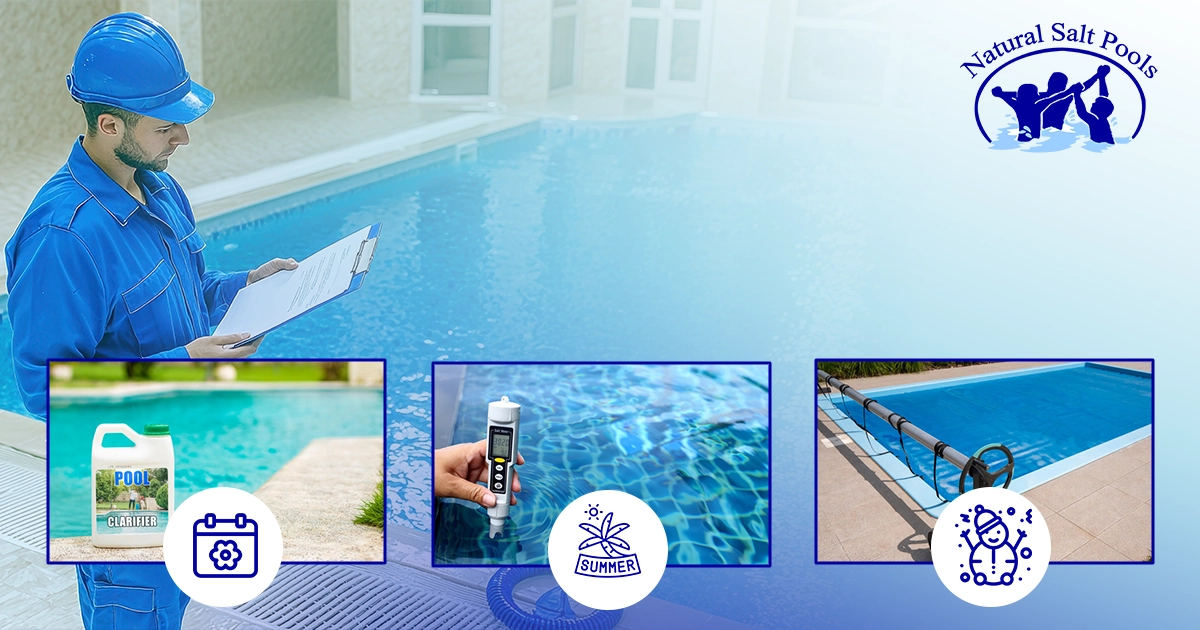Mastering pool chemistry entails creating a maintenance plan that considers the link between water balance, sanitizer levels, and year-round pool maintenance. Pool chemical balance can ensure your pool remains in top condition year-round while preventing common chemical imbalances. Here’s a comprehensive pool chemical maintenance plan to help you keep your pool chemistry balanced throughout the year:
Spring maintenance plan (opening the pool)
- Test Water: Check pH (7.2–7.6), total alkalinity (80–120 ppm), and calcium hardness (200–400 ppm).
- Shock the pool: Use chlorine shock to eliminate contaminants. Aim for a chlorine level of 1-3 ppm.
- Adjust alkalinity and pH: If needed, raise alkalinity first, then adjust the pH with a pH increaser or reducer.
- Algaecide application: Use an algaecide to prevent algae blooms during warmer months.
- Stabilizer (Cyanuric acid): Keep cyanuric acid at 30-50 ppm to protect chlorine from UV degradation.
Summer Maintenance Plan (Peak Season)
- Test water weekly: At least once a week, test pH, alkalinity, calcium hardness, and chlorine levels.
- Maintain chlorine levels: Ensure chlorine stays between 1-3 ppm. Consider using stabilized chlorine or adding cyanuric acid if needed.
- Shock every 1-2 weeks: This is essential during high usage or after heavy rainfall.
- Monitor pH and alkalinity: Hot weather can increase pH levels. Keep pH between 7.2 and 7.6, and alkalinity between 80 and 120 ppm.
- Check for calcium hardness: Maintain calcium hardness at 200-400 ppm to prevent scale buildup or corrosion.
- Algaecide: Regular algaecide treatments to minimize algae growth.
Fall maintenance plan (Prepping for winterization)
- Test water: Similar to spring, check pH, alkalinity, and calcium hardness.
- Shock the pool: Perform a final shock treatment before closing.
- Lower water level: If applicable, lower the pool’s water level to below the skimmer.
- Algaecide application: Add a winter algaecide to prevent algae growth during closing.
- Cover the Pool: To keep debris out and protect the water chemistry, use a quality pool cover.
Winter Maintenance Plan (Closed Pool)
- Test water every 1-2 months: Test pH and alkalinity even when the pool is closed to ensure it remains balanced.
- Maintain water chemistry: Keep pH at 7.2–7.6 and alkalinity at 80–120 ppm during the winter months.
- Monitor calcium levels: Keep calcium hardness within 200-400 ppm to prevent scaling.
- Check cover regularly: Inspect your pool cover for damage or debris buildup.

Seasonal Tips for Maintaining Optimal Pool Chemistry Throughout the Year.
Seasonal pool chemistry can preserve clean, healthy water throughout the year, preventing expensive repairs and excessive chemical usage. Here are a few seasonal pool care tips to help you maintain optimal pool chemistry throughout the year:
- Spring tips (Prepping for pool opening): In spring, the focus is on rebalancing pool chemistry after winter. Start by testing the water for pH, alkalinity, and calcium hardness, and make necessary adjustments. Shocking the pool is crucial to eliminating contaminants that accumulated during the off-season. Apply an algaecide to prevent early algae growth as temperatures rise, and add a stabilizer (cyanuric acid) to protect chlorine from UV rays.
- Summer tips (Managing heat and high usage): During summer, frequent testing is key to maintaining water balance. Hot weather, heavy usage, and rain can all affect pH and chlorine levels, so make sure that chlorine remains between 1-3 ppm. Regularly shock the pool every 1-2 weeks to counteract increased swimmer load and organic contaminants. The heat may cause the pH to rise, so monitor the alkalinity to prevent fluctuations and regularly apply algaecide to prevent algae growth.
- Fall tips (Prepping for pool closing): As the swimming season winds down, focus on stabilizing the water before closing the pool. Test and adjust pH, alkalinity, and calcium hardness to recommended levels. Perform a final shock to eliminate any lingering bacteria or algae, and lower the water level if needed for winter. Apply a high-quality winter algaecide and make sure to securely cover the pool to shield it from debris and cold-weather damage.
- Winter tips (Monitoring during pool closure): Even when your pool is closed for winter, it’s important to monitor water chemistry every 1-2 months. Keep pH and alkalinity in the ideal range to prevent any chemical damage to the pool’s surfaces. Check the calcium hardness to prevent scaling or corrosion. Check the pool cover regularly for tears or debris buildup, as these can lead to imbalances upon reopening the pool.


Leave a Reply